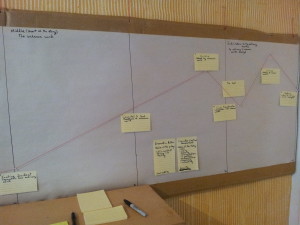 While I often recommend books on writing, I don’t think I’ve ever felt as strongly about a books as I do about The Plot Whisperer, by Martha Alderson. Special thanks to Amanda June Hagarty for recommending it to me.
While I often recommend books on writing, I don’t think I’ve ever felt as strongly about a books as I do about The Plot Whisperer, by Martha Alderson. Special thanks to Amanda June Hagarty for recommending it to me.
If you have not read this book and you wish to write books, GO BUY IT RIGHT NOW. In fact, you could probably skip the rest of this blog series and get your questions answered a lot quicker and more accurately than I could possibly manage. So go, just go, now, follow the link and buy this book.
Still here? Well, it’s your loss, but I’ll do my best to summarize what I’ve learned so far (I’m only three chapters in) about turning your burning story into a readable book.
It begins with a structure Alderson calls the universal story. Here’s my interpretation of the universal story in a nutshell: The protagonist is presented to the reader as they exist in the ordinary world, before everything goes haywire. About a quarter of the way through the book, the protagonist experiences an inciting incident which draws (or drags) them out of the ordinary world and into the unknown. The protagonist’s goals propel them forward in the story; obstacles posed by the antagonist create conflicts in the protagonist’s journey. Midway through the book, something happens in the plot that causes the protag to fully commit to his or her goals, right before the going gets really hard. The obstacles increase until it appears that the antag has won. In the light of this apparent victory, the protag experiences a fall accompanied by a transformation in which the protag rallies for the final conflict. In the final conflict, the protag succeeds (or fails) at defeating the antag. Finally, the protag returns to the ordinary world, but changed.
Pick up any book on your shelf and it will follow this structure. The transition from the ordinary world to the unknown is not always physical, like in Alice in Wonderland; more often than not it’s a change in the ordinary world that casts the protagonist out into the unknown. It could be something like a wacky neighbor moving in across the street, or a child suddenly finding themselves home alone for the holidays, or falling in love at first sight.
I was so excited when I started reading the Plot Whisperer that I tried to explain it to Hans, and his response (bless his heart) was, “You’re not going to write your books like that, are you?”
His objection being, that to follow such a specific structure would result in a formulaic book. I’m glad he asked the question, because it forced me to try to articulate why it does make sense to stretch the skin of your story over a structure that could be seen as over-used.
In fact, the story I am writing, and the one you are writing or want to write, and every story ever written, has this structure in it inherently. This is the nature of stories. It’s not a matter of trying to structure your story to fit it; it’s a matter of understanding the inherent structure of all stories in order to see why/where yours isn’t working. If you’re having issues at any stage in your plot, it’s probably because you’re missing one of the above steps, or have it in the wrong place, or haven’t fully realized its potential.
I should add a side note that it is possible that other cultures use different structures (although, it is my understanding that some guy called Joseph Campbell studied this pretty thoroughly and came up with a very similar format called the Hero’s Journey that applied to pretty much every single myth ever told by human beings). It’s also probable that some experimental versions of story have veered away from this format with mixed results. For most beginning writers, however, (myself included) deviation from this form is probably just an attempt to jerry-rig problems that should be fixed within the form.
Just a couple more points in case you’re not convinced that this is the best thing since sliced bread:
Alderson came to her version of the universal story by sitting down and plotting out many classical novels. She has also given plot consultations to hundreds of writers of all levels of ability, so she, far more than me, knows whereof she speaks. She didn’t make this up out of thin air, any more than Campbell made up the Hero’s Journey.
Finally, when I understood what Alderson meant by universal story, I realized that I recognized it. I’ve been writing it intuitively for years without realizing it. Writing it wrong more often than not, but still writing it. Now, it’s possible that this is happening because the universal story is a constant, a specific way in which the brain processes information. Or it could just be because I’ve been reading it since I was old enough to hold a book in my hands.
So . . . how do you transform your story into the universal story?
Essentially, by aligning character development with dramatic action with thematic significance. Different types of writers (Alderson goes into this in greater detail, explaining how to recognize what type you are, what challenges each type faces, strategies for overcoming these challenges) tend to approach the story from their predilection, neglecting the other two. For example, I tend to think in terms of dramatic events first (this happened, then this happened, which caused this to happen) while neglecting the effects of those events on the characters, and also neglecting the way that the characters’ motives generate events.
Alderson lays out a plot planner, where you plan not only the dramatic action but also the character development of each scene. Now, I’ve tried doing similar things before with mixed results. It never really stuck. But the format presented in The Plot Whisperer forces you to connect event to character development to theme.
Needless to say, I’m adapting it to fit my own needs. For example, she presents it chapter by chapter and recommends plotting out every single scene like that. So far, all I’ve had the impetus to do is plot out the major scenes, the ones that correspond to the crucial incidents of the universal story:
- Inciting incident (1/4) Separation from the ordinary world
- Committal to goal (1/2) Acceptance of unknown world
- Crisis (almost 3/4) Defeat by unknown world
- Final transformation (3/4) Integration into unknown world
- Climax (between 3/4 and end) Mastery of the unknown
- Return (end) Return to the ordinary world, carrying unknown world within
But just plotting out those five scenes has revealed that I have a lot of holes in a plot I thought was solid (no surprise: most of the holes are in the Character emotional development column). And this is where I ran into problems drafting Book II: I drafted it while it still had significant gaps in the development of the main character. I was able to fix the gaps (I hope), but not without a huge amount of re-writing.
Whatever form your story is in, whether it’s a rough draft, in progress, in some kind of summary or outline, or merely in your head, sit down and figure out which scenes correspond to these six plot points. There’s a good chance that you’ll be missing some, or that the scene you thought was the climax is actually the crisis, or that you have your final transformation occurring right after the inciting incident. As you do this, remember that each of these scenes should include dramatic events, character development, and details that link the story back into a universal theme.
You might find, like I have, that just plotting out these six scenes will cause the pieces of the plot you were struggling to hold together to fall into place. That’s probably, just a guess here, because now we’re working with the inherent structure of story instead of against it.
One final note on this subject: the matter becomes more complicated if you are writing a series. When you’re writing a series, the series as a whole needs to fit this structure, as does each individual book within the series. (I should clarify that I’m talking about a specific type of series common to epic fantasy and a few other genres. Many successful series do not have an over-arching story that encompasses the entire series)
This idea is causing me to look at the structure of the series differently. For example, in DVBC, you could say that that whole book is written in the ordinary world (Sholaen) with the inciting incident for the series being the transition to the unknown world at the end. Dream of a City of Ruin has the heroine starting to know the unknown world, and it ends with a commitment to a goal regarding the unknown world. And Book III, Shattered Dreams, is very much the crisis point of the whole story. And now I have some ideas to focus books four and five, which will respectively be about transformation and climax.
Pretty cool, huh? See what I mean by doing it intuitively? There are probably writers out there (lucky s.o.b.’s) who can do this flawlessly without ever looking at a plot planner. For the rest of us, knowledge of the form allows us greater control over this messy process called writing.
So, don’t be like me and stumble around in your draft until you figure it out intuitively. Go out now and get a copy of The Plot Whisperer!



One thought on “101 TIWIK #50: Planning: From Story to Book”
Thank you for this!